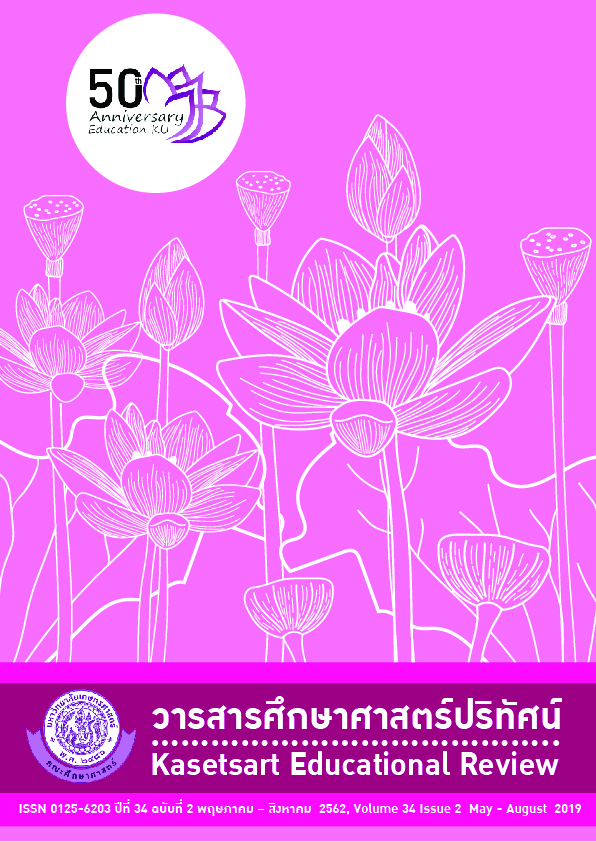ทักษะการกำกับการเรียนรู้ของผู้เรียนในศตวรรษที่ 21
คำสำคัญ:
ทักษะการกํากับการเรียนรู้, ศตวรรษที่ 21บทคัดย่อ
ทักษะการกํากับการเรียนรู้เป็นหนึ่งในทักษะที่ สําคัญของผู้เรียนในยุคศตวรรษที่ 21 ซึ่งเป็นยุคที่มี การเปลี่ยนแปลงในหลาย ๆ ด้านโดยเฉพาะด้านการศึกษา และการเรียนรู้ของผู้เรียนการกํากับการเรียนรู้มีลักษณะ เป็นกระบวนการที่มีความเกี่ยวข้องกับปัจจัยส่วนบุคคลใน ด้านพฤติกรรม ความคิดและแรงจูงใจของบุคคล รวมถึงมี ความเกี่ยวข้องกับปัจจัยทางสังคมในอดีตที่ผ่านมา นักการศึกษาและนักวิจัยส่วนใหญ่ได้ให้ความสําคัญต่อ การศึกษาตัวแปรด้านกํากับตนเองในการเรียนรู้ของผู้เรียน เป็นหลักแต่จากการศึกษาพบว่า การกํากับการเรียนรู้ใน ศตวรรษที่ 21 นั้นได้ขยายขอบเขตจากการกํากับตนเองใน การเรียนรู้ไปสู่การกํากับร่วมกันในการเรียนรู้ของผู้เรียนอีก ด้วย ซึ่งเป็นการใช้ประโยชน์จากปัจจัยทางสังคมใน การพัฒนาการเรียนรู้ของผู้เรียน ดังนั้นการกํากับการเรียนรู้ ในศตวรรษที่ 21 จึงให้ความสําคัญทั้งด้านการกํากับตนเอง และการกํากับร่วมกันในการเรียนรู้ของผู้เรียนซึ่งจะส่งผลให้ ผู้เรียนมีการเรียนรู้ที่มีประสิทธิภาพเพิ่มขึ้น
เอกสารอ้างอิง
Allal, L. 2011. “Pedagogy, didactics and the co-regulation of learning: a perspective from the French-language.” World of Educational Research26(3): 329-346.
Avi, K. (2008). Clarifying Metacognition, Self-Regulation and Self-Regulation Learning: What’s purpose. Educ Psychol,20, 477-489.
Bandura, A. 1986. Social Foundation of Thought and Action : A Social Cognitive Theory. New Jersey: Prentise Hall.
Carol, K. C. 2012.“Co-regulation of learning in computer-supported collaborative learning environments: a discussion”Metacognition and Learning. 7.:63-73.
Christopher, A. W.2010.Self- Regulated Learning and the 21 Century Competencies. Dissertation, Ph.D. (Educational Psychology).Graduate school University of Houston.
Clark, I. 2012. “Formative Assessment: Assessment Is for Self-regulated Learning” Educational Psychology.24: 205-249.
Emmi, S., Kirsi P., Auli T., Janne P. & Tiina S.(2015). Student teachers’ self- and co-regulation of learning during teacher education. Taylor & Francis Group, 20(1), 44-63.
Eric, C. K. 2011. “The role of self-regulated learning in enhancing learning Performance.” The International Journal of Research and Review. 6(1):1-16.
Fermin, T. M. ; & Maria, C.G. 2004. “Self- Regulated Learning: Current and Future Direction.” Electronic Journal of Research in Educational Psychology.2 (1) :108-116.
Hadwin, A. F.; Sanna.J. ;& Miller M. 2011. Self-Regulated, Co-Regulated, and Socially Share Regulation of Learning. Handbook of Self Regulation of Learning and Performance. London: Routledge.
International Commission on Education. (2008). Learning: The Treasure Within:Report to UNESCO of the International Commission on Education for Twenty – First Century. Bangkok: Office of the Education Council.
Nicole, C. D.2012. “Effective Self- and Co-Regulation in Collaborative Learning groups: An analysis of How Students Regulate Problem Solving of Authentic Interdisciplinary Tasks.” Instruction Science 41: 25-47.
Office of the Basic Education Commission. (2015). Plan for Education Reform. Bangkok: Office of the Basic Education Commission. (In Thai)
Paris, S. G.2003. The Role of Self-Regulated Learning in Contextual Teaching: Principles and Practices for Teacher Preparation. Commissioned Paper .University of Michigan
Philip, B.;&Hua, T. K.2006. “Metacognitive Strategy Instruction (MSI) for Reading Co-Regulation of Cognition.” Journal e-Bangi. 1(1):1-27.
Pintrich, P. R. 2000. The role of goal orientation in self-regulated learning. In M. Boekaerts,P. R. Pintrich, & M. Zeidner, (Eds.), Handbook of self-regulation: Theory, research, and applications San Diego, CA: Academic Press.
Roll.;Eliane, S. W.; Yanjin, L.; Vincent A.;& Kenneth R. 2011. “Tutoring Self- and Co- Regulation with Intelligent Tutoring Systems to Help Students Acquire Better Learning Skills.” Design Recommendations for Intelligent Tutoring Systems.2:169-182.
Schraw, G.; Kent, J.C.;&Kendall H. 2006.“Promoting Self-Regulation in Science Education: Metacognition as Part of A Broader Perspective on Learning.”Research in Science Education. 1 (1): 1-27.
Schunk, D. H. 1991. “Self-Efficacy and Academic Motivation.” Educational PsychologyReview. 26:207-231.
Schunk, D.H.;& Zimmerman, B. J.1994. Self – Regulated Learning. From Teaching to Self- Reflective Practice. New York: The Guilford Press.
Sharon, Z.; Joseph,T; & Elizabeth, D. R. 2011. Encouraging Sef-Regulated Learning in The Classroom: A Review of Literature.Educational Research.Verginia Commonwealth University.
Luksaneeyanawin, S. (2010). Learning to Changing.Bangkok: Professional and Organizational Development Network of Thailand Higher Education. (In Thai)
Volet, S., Mark, S. & Joanne, T. 2008. High-level Co-Regulation in Collaborative Learning: How Does It Emerge and How Is It Sustained. Learning and Instruction, 19(12), 128-143.
Vrieling, E., Bastiaens, T. & Stijnen, P. (2012). Promoting Self –Regulated Learning on Primary Teacher Education. University Pers Maastricht.
Panich, W. (2011). The way of learning in 21st Century. Bangkok: Sodsri- Saridwong Foundation. (In Thai).
Winne, P. H. (1996).“A Metacognitive View of Individual Differences in Self-Regulated Learning.” Learning and Individual Differences.8(4), 327-353.
Winter, F.I. & Azevedo, R. (2005). High-School Student Regulation’s of Learning during Computer-Based Science Inquiry. Journal Educational Computing Research.33(2), 189-217.
Zimmerman, B. J. (1989). A Social Cognitive View of Self-Regulated Academic Learning. Journal of Educational Psychology.81(3), 329-339.
______. 2002. Becoming A Self-Regulated Learner: An overview. Theory into Practice. 41(2), 64-70.
ดาวน์โหลด
เผยแพร่แล้ว
ฉบับ
ประเภทบทความ
สัญญาอนุญาต
บทความทุกบทความเป็นลิขสิทธิ์ของวารสารคณะศึกษาศาสตร์ มหาวิทยาลัยเกษตรศาสตร์ วิทยาเขตบางเขน
วารสารศึกษาศาสตร์ปริทัศน์ (Kasetsart Educational Review)






